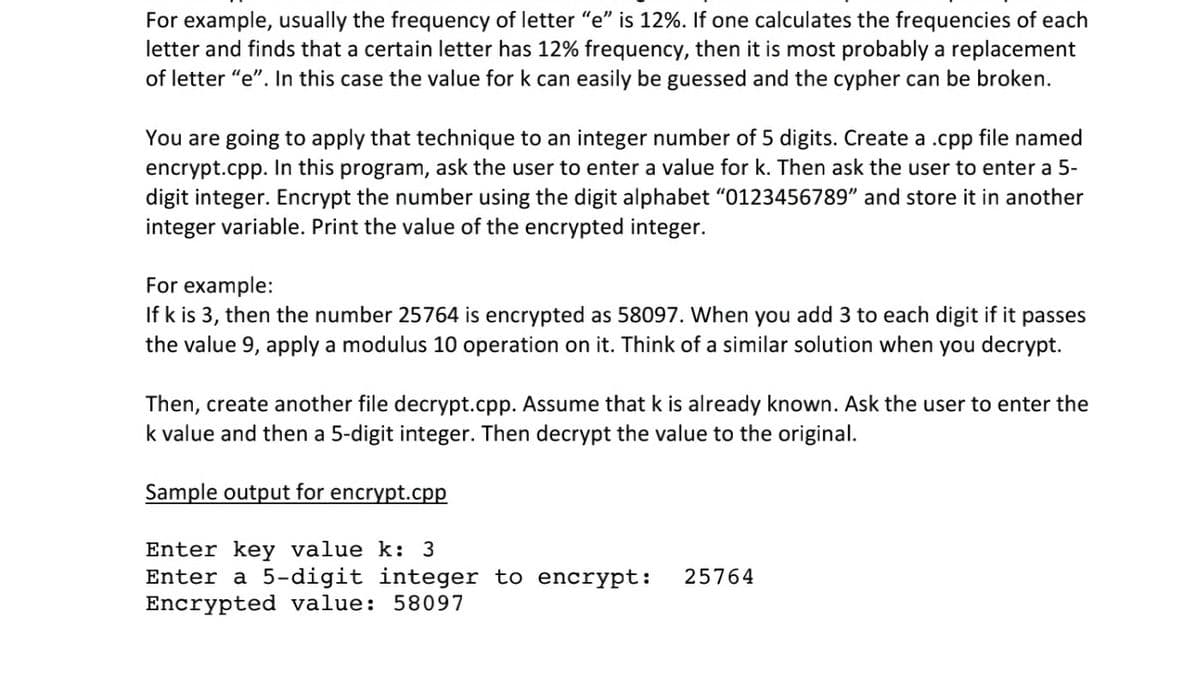You are going to apply that technique to an integer number of 5 digits. Create a .cpp file named encrypt.cpp. In this program, ask the user to enter a value for k. Then ask the user to enter a 5- digit integer. Encrypt the number using the digit alphabet "0123456789" and store it in another integer variable. Print the value of the encrypted integer. For example: If k is 3, then the number 25764 is encrypted as 58097. When you add 3 to each digit if it passes the value 9, apply a modulus 10 operation on it. Think of a similar solution when you decrypt. Then, create another file decrypt.cpp. Assume that k is already known. Ask the user to enter the k value and then a 5-digit integer. Then decrypt the value to the original.
You are going to apply that technique to an integer number of 5 digits. Create a .cpp file named encrypt.cpp. In this program, ask the user to enter a value for k. Then ask the user to enter a 5- digit integer. Encrypt the number using the digit alphabet "0123456789" and store it in another integer variable. Print the value of the encrypted integer. For example: If k is 3, then the number 25764 is encrypted as 58097. When you add 3 to each digit if it passes the value 9, apply a modulus 10 operation on it. Think of a similar solution when you decrypt. Then, create another file decrypt.cpp. Assume that k is already known. Ask the user to enter the k value and then a 5-digit integer. Then decrypt the value to the original.
Chapter13: File Input And Output
Section: Chapter Questions
Problem 6PE
Related questions
Question
C++ Nothing too advanced please. Learning the basics
#include <iostream>
using namespace std;
int main()

Transcribed Image Text:For example, usually the frequency of letter "e" is 12%. If one calculates the frequencies of each
letter and finds that a certain letter has 12% frequency, then it is most probably a replacement
of letter "e". In this case the value for k can easily be guessed and the cypher can be broken.
You are going to apply that technique to an integer number of 5 digits. Create a .cpp file named
encrypt.cpp. In this program, ask the user to enter a value for k. Then ask the user to enter a 5-
digit integer. Encrypt the number using the digit alphabet "0123456789" and store it in another
integer variable. Print the value of the encrypted integer.
For example:
If k is 3, then the number 25764 is encrypted as 58097. When you add 3 to each digit if it
the value 9, apply a modulus 10 operation on it. Think of a similar solution when you decrypt.
passes
Then, create another file decrypt.cpp. Assume that k is already known. Ask the user to enter the
k value and then a 5-digit integer. Then decrypt the value to the original.
Sample output for encrypt.cpp
Enter key value k: 3
Enter a 5-digit integer to encrypt:
Encrypted value: 58097
25764
Expert Solution
This question has been solved!
Explore an expertly crafted, step-by-step solution for a thorough understanding of key concepts.
This is a popular solution!
Trending now
This is a popular solution!
Step by step
Solved in 2 steps with 4 images

Knowledge Booster
Learn more about
Need a deep-dive on the concept behind this application? Look no further. Learn more about this topic, computer-science and related others by exploring similar questions and additional content below.Recommended textbooks for you

EBK JAVA PROGRAMMING
Computer Science
ISBN:
9781337671385
Author:
FARRELL
Publisher:
CENGAGE LEARNING - CONSIGNMENT

EBK JAVA PROGRAMMING
Computer Science
ISBN:
9781337671385
Author:
FARRELL
Publisher:
CENGAGE LEARNING - CONSIGNMENT